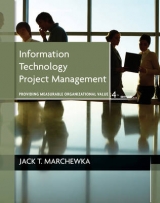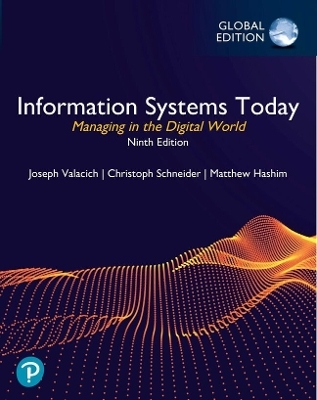
Information Technology Project Management
John Wiley & Sons Inc
978-0-470-37193-0 (ISBN)
- Titel erscheint in neuer Auflage
- Artikel merken
The Third Edition of Jack Marchewka’s Information Technology Project Management focuses on how to create Measurable Organizational Value (MOV) through IT projects. The author uses the concept of MOV, combined with his own research, to create a solid foundation for making decisions throughout the project’s lifecycle. The book’s integration of project management and IT concepts provides students with the tools and techniques they need to develop in this field.
Jack T. Marchewka is an associate professor, the Barsema Professor of Management Information Systems, and the director of the Business Information Technology Transfer Center (BITTC) at Northern Illinois University. He received his Ph.D. from Georgia State University's department of Computer Information Systems in 1994 and was a former faculty member at Kennesaw State University. Prior to entering academia, Dr. Marchewka was a vice president of MIS for a healthcare company in Atlanta, Georgia. Dr. Marchewka has taught a number of courses at both the undergraduate and graduate levels and has been a guest lecturer at the Rotterdam School of Management, Erasmus University in the Netherlands. His articles have appeared in journals such as Information Resources Management Journal, Information Technology & People, Journal of International Information Management, and Journal of Informatics Education and Research.
Preface xxi
About The Author xxvii
CHAPTER 1 The Nature of Information Technology Projects 1
Introduction 1
The Purpose of This Book 5
The State of IT Project Management 5
Why IT Projects Fail 7
Improving the Likelihood of Success 10
A Value-Driven Approach 10
A Socio-Technical Approach 10
A Project-Management Approach 10
A Knowledge-Management Approach 12
The Context of Project Management 13
What Is a Project? 13
Attributes of a Project 14
The Project Life Cycle and IT Development 16
Define Project Goal 17
Plan Project 18
Execute Project Plan 18
Close Project 18
Evaluate Project 18
The Systems Development Life Cycle (SDLC) 19
Planning 19
Analysis 19
Design 20
Implementation 20
Maintenance and Support 20
Implementing the SDLC 20
Structured Approach to Systems Development 21
Iterative Systems Development 22
The PLC and the SDLC 23
Extreme Project Management 24
The Project Management Body of Knowledge (PMBOK) 25
Project Management Knowledge Areas 25
Chapter Summary 27
Review Questions 28
Extend Your Knowledge 28
Global Technology Solutions 29
Husky Air—Pilot Angels 29
Husky Air Assignment 30
Case Studies 31
Bibliography 33
CHAPTER 2 Conceptualizing and Initializing the IT Project 34
Introduction 34
An Information Technology Project Methodology (ITPM) 35
Phase 1: Conceptualize and Initialize 37
Phase 2: Develop the Project Charter and Detailed Project Plan 37
Phase 3: Execute and Control the Project 38
Phase 4: Close Project 39
Phase 5: Evaluate Project Success 39
IT Project Management Foundation 40
Project Management Process Group 40
Project Objectives 40
Tools 41
Infrastructure 41
Project Management Knowledge Areas 41
The Business Case 42
What Is a Business Case? 42
Developing the Business Case 42
Step 1: Select the Core Team 43
Step 2: Define Measurable Organizational Value (MOV) 44
Step 3: Identify Alternatives 51
Step 4: Define Feasibility and Assess Risk 51
Step 5: Define Total Cost of Ownership 52
Step 6: Define Total Benefits of Ownership 53
Step 7: Analyze Alternatives 53
Step 8: Propose and Support the Recommendation 58
Project Selection and Approval 58
The IT Project Selection Process 60
The Project Selection Decision 60
IT Governance and the Project Management Office 63
The Project Management Office (PMO) 66
Chapter Summary 66
Review Questions 67
Extend Your Knowledge 68
Global Technology Solutions 68
Husky Air Assignment—Pilot Angels 69
Case Studies 71
Bibliography 74
CHAPTER 3 Developing the Project Charter and Baseline Project Plan 76
Introduction 76
Project Management Processes 77
Project Management Process Groups 79
Initiating 79
Planning 80
Executing 81
Monitoring and Controlling 81
Closing 81
Project Integration Management 81
The Project Charter 83
What Should Be in a Project Charter? 84
Project Identification 85
Project Stakeholders 85
Project Description 86
Measurable Organizational Value (MOV) 86
Project Scope 86
Project Schedule 87
Project Budget 87
Quality Issues 87
Resources 87
Assumptions and Risks 87
Project Administration 88
Acceptance and Approval 88
References 88
Terminology 88
Project Planning Framework 88
The MOV 90
Define the Project’s Scope 90
Subdivide the Project into Phases 91
Tasks—Sequence, Resources, and Time Estimates 91
Sequence 91
Resources 92
Time 92
Schedule and Budget—The Baseline Plan 92
The Kick-Off Meeting 93
Chapter Summary 93
Review Questions 94
Extend Your Knowledge 94
Global Technology Solutions 95
Husky Air Assignment—Pilot Angels 96
Case Studies 96
Bibliography 99
CHAPTER 4 The Human Side of Project Management 100
Introduction 100
Organization and Project Planning 102
The Formal Organization 102
The Functional Organization 102
The Project Organization 105
The Matrix Organization 107
Which Organizational Structure Is Best? 109
The Informal Organization 110
Stakeholders 110
Stakeholder Analysis 110
The Project Team 111
The Roles of the Project Manager 111
Team Selection and Acquisition 113
Team Performance 114
Work Groups 114
Real Teams 115
Project Teams and Knowledge Management 117
Learning Cycles and Lessons Learned 118
The Project Environment 122
Chapter Summary 125
Review Questions 126
Extend Your Knowledge 126
Global Technology Solutions 127
Husky Air Assignment—Pilot Angels 128
Case Studies 129
Bibliography 132
CHAPTER 5 Defining and Managing Project Scope 133
Introduction 133
Project Scope Management Processes 133
Scope Planning 136
Scope Boundary 136
The Scope Statement 136
Scope Statement 137
Out of Scope for This Project 137
Project Scope Definition 138
Project-Oriented Scope 138
Project-Oriented Scope Definition Tools 138
Product-Oriented Scope 140
Product-Oriented Scope Definition Tools 140
Project Scope Verification 144
Scope Change Control 144
Scope Change Control Procedures 145
Benefits of Scope Control 147
Chapter Summary 147
Review Questions 148
Extend Your Knowledge 149
Global Technology Solutions 149
Husky Air Assignment—Pilot Angels 150
Case Studies 150
Bibliography 152
CHAPTER 6 The Work Breakdown Structure and Project Estimation 153
Introduction 153
The Work Breakdown Structure (WBS) 154
Work Packages 155
Deliverables and Milestones 155
Developing the WBS 156
The WBS Should Be Deliverable Oriented 158
The WBS Should Support the Project’s MOV 158
The Level of Detail Should Support Planning and Control 159
Developing the WBS Should Involve the People Who Will Be Doing the Work 159
Learning Cycles and Lessons Learned Can Support the Development of a WBS 159
Project Estimation 159
Guesstimating 160
Delphi Technique 160
Time Boxing 161
Top-Down Estimating 161
Bottom-Up Estimating 162
Software Engineering Metrics and Approaches 163
Lines of Code (LOC) 164
Function Points 165
COCOMO 168
Heuristics 170
Automated Estimating Tools 171
What is the Best Way to Estimate IT Projects? 171
Chapter Summary 172
Web Sites to Visit 173
Review Questions 174
Extend Your Knowledge 174
Global Technology Solutions 175
Husky Air Assignment—Pilot Angels 176
Case Studies 177
Bibliography 179
CHAPTER 7 The Project Schedule and Budget 180
Introduction 180
Developing the Project Schedule 181
Gantt Charts 182
Project Network Diagrams 183
Activity on the Node (AON) 183
Critical Path Analysis 185
PERT 186
Precedence Diagramming Method (PDM) 188
Critical Chain Project Management (CCPM) 189
Project Management Software Tools 191
Developing the Project Budget 193
Cost Estimation 193
Other Costs 196
Resource Allocation 198
Finalizing the Project Schedule and Budget 199
Chapter Summary 199
Review Questions 199
Extend Your Knowledge 200
Global Technology Solutions 200
Husky Air Assignment—Pilot Angels 201
Case Studies 202
Bibliography 204
CHAPTER 8 Managing Project Risk 205
Introduction 205
IT Project Risk Management Planning Process 207
Risk Planning 209
Risk Identification 210
Risk Assessment 210
Risk Strategies 210
Risk Monitoring and Control 211
Risk Response 211
Risk Evaluation 211
Identifying IT Project Risks 211
An IT Project Risk Identification Framework 211
Applying the IT Project Risk Identification Framework 213
Tools and Techniques 215
Risk Analysis and Assessment 217
Qualitative Approaches 218
Expected Value 218
Decision Trees 219
Risk Impact Table 219
Quantitative Approaches 222
Discrete Probability Distributions 222
Continuous Probability Distributions 222
PERT Distribution 224
Triangular Distribution 224
Simulations 225
Risk Strategies 228
Risk Monitoring and Control 230
Risk Response and Evaluation 232
Chapter Summary 233
Web Sites to Visit 234
Review Questions 234
Extend Your Knowledge 235
Global Technology Solutions 235
Husky Air Assignment—Pilot Angels 236
Case Studies 237
Bibliography 239
CHAPTER 9 Project Communicaton, Tracking, and Reporting 240
Introduction 240
Monitoring and Controlling the Project 242
The Project Communications Plan 243
Project Metrics 246
Earned Value 247
Reporting Performance and Progress 253
Information Distribution 254
Chapter Summary 257
Review Questions 257
Extend Your Knowledge 258
Global Technology Solutions 258
Husky Air Assignment—Pilot Angels 259
Case Studies 260
Bibliography 262
CHAPTER 10 IT Project Quality Management 263
Introduction 263
Quality Tools and Philosophies 267
Scientific Management 267
Control Charts 268
The Total Quality Movement 269
Quality Planning, Improvement, and Control 271
Cause and Effect of Diagrams, Pareto Charts, and Flow Charts 272
Quality Systems 274
International Organization for Standardization (ISO) 274
Six Sigma (6σ ) 275
The Capability Maturity Model Integration (CMMI) 277
Level 1: Initial 280
Level 2: Repeatable 280
Level 3: Defined 280
Level 4: Managed 281
Level 5: Optimizing 281
The IT Project Quality Plan 283
Quality Philosophies and Principles 283
Focus on Customer Satisfaction 284
Prevention, Not Inspection 284
Improve the Process to Improve the Product 284
Quality Is Everyone’s Responsibility 285
Fact-Based Management 285
Quality Standards and Metrics 285
Verification and Validation 286
Change Control and Configuration Management 288
Monitor and Control 290
Learn, Mature, and Improve 291
Chapter Summary 292
Review Questions 293
Extend Your Knowledge 294
Global Technology Solutions 295
Husky Air Assignment—Pilot Angels 296
Case Studies 297
Bibliography 298
CHAPTER 11 Managing Organizational Change, Resistance, and Conflict 299
Introduction 299
The Nature of Change 302
Change Has an Impact 302
Change Is a Process 303
Change Can Be Emotional 304
The Change Management Plan 306
Assess Willingness, Readiness, and Ability to Change 306
Sponsor 306
Change Agents 307
Targets 307
Develop or Adopt a Strategy for Change 308
Rational-Empirical Approach 308
Normative-Reeducation Approach 309
Power-Coercive Approach 309
Environmental-Adaptive Approach 310
Implement the Change Management Plan and Track Progress 310
Evaluate Experience and Develop Lessons Learned 311
Dealing with Resistance and Conflict 311
Resistance 311
Conflict 312
Chapter Summary 315
Review Questions 316
Extend Your Knowledge 318
Global Technology Solutions 318
Husky Air Assignment—Pilot Angels 319
Case Studies 320
Bibliography 323
CHAPTER 12 Project Procurement Management and Outsourcing 324
Introduction 324
Project Procurement Management 325
The Project Procurement Management Processes 326
Plan Purchases and Acquisition 326
Plan Contracting 327
Request Seller Responses 327
Select Sellers 328
Contract Administration 330
Contract Closure 330
Outsourcing 331
The Beginning of the Outsourcing Phenomenon 331
Types of Outsourcing Relationships 332
The Realities of Outsourcing 332
Managing the Outsourcing Relationship 333
Chapter Summary 335
Review Questions 336
Extend Your Knowledge 337
Global Technology Solutions 337
Husky Air Assignment—Pilot Angels 338
Case Studies 338
Bibliography 340
CHAPTER 13 Leadership and Ethics 341
Introduction 341
Project Leadership 342
Some Modern Approaches to Leadership 343
Leadership Styles 344
Emotional Intelligence 346
Ethics in Projects 348
Ethical Leadership 350
Common Ethical Dilemmas 351
Making Sound Ethical Decisions 352
Codes of Ethics and Professional Practices 354
Multicultural Projects 355
The Challenges of International Projects 355
Understanding and Managing Diversity 357
Chapter Summary 358
Review Questions 359
Extend Your Knowledge 360
Global Technology Solutions 360
Husky Air Assignment—Pilot Angels 361
Case Studies 362
Bibliography 363
CHAPTER 14 Project Implementation, Closure, and Evaluation 364
Introduction 364
Project Implementation 365
Direct Cutover 366
Parallel 366
Phased 367
Administrative Closure 368
Project Sponsor Acceptance 371
The Final Project Report 371
The Final Meeting and Presentation 372
Closing the Project 373
Project Evaluation 373
Individual Performance Review 373
Postmortem Review 374
Project Audit 375
Evaluating Project Success—The MOV 376
Chapter Summary 377
Review Questions 378
Extend Your Knowledge 379
Global Technology Solutions 380
Husky Air Assignment—Pilot Angels 380
Case Studies 381
Bibliography 383
APPENDIX: An Introduction to Function Point Analysis 384
Index 397
| Erscheint lt. Verlag | 19.1.2009 |
|---|---|
| Verlagsort | New York |
| Sprache | englisch |
| Maße | 203 x 253 mm |
| Gewicht | 706 g |
| Themenwelt | Mathematik / Informatik ► Mathematik ► Finanz- / Wirtschaftsmathematik |
| Wirtschaft ► Betriebswirtschaft / Management ► Projektmanagement | |
| ISBN-10 | 0-470-37193-5 / 0470371935 |
| ISBN-13 | 978-0-470-37193-0 / 9780470371930 |
| Zustand | Neuware |
| Haben Sie eine Frage zum Produkt? |
aus dem Bereich



